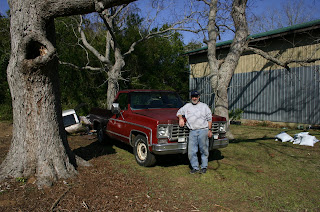


My dad is one of the hardest working people I have ever met...I appreciate the trait he has passed on to me through both genes and example. Growing up as the oldest son on a farm in Michigan, my father learned an iron clad work ethic without choice. He had duties and loyalties to fulfill for the sake of the family. His constant drive is both impressive to watch and exhausting to experience for anyone else participating. As soon as his noodle arms were able (about age 9), he woke up with Grandpa Davis at 4:00 AM to milk the cows and perform all of the morning farm chores before school (feed the pigs and chickens). This continued for the next nine years until the guidance counselor at Plainwell High School suddenly declared that he was awarded a full ride to University of Michigan. His farming experience was not one decided because Richard (Grandpa) was a life long farmer but instead was chosen out of necessity. The family had to eat. After flying in B-24 bombers as a flight engineer (got shot down three times and escaped via parachute) in World War II, my grandpa worked as the lead welder at a paper mill in Plainwell, Michigan. He lived a life marked by hard work that centered around family. Now that I am starting a farm some 60 years later, I feel especially close to my grandparents...trying to awaken the green thumb that lies buried beneath a suburban childhood.
Last week I had to rent a truck from Lowe's to drive around James Island picking up bagged leaves for mulch. I was telling my dad a story about getting pulled over by a cop for losing a bag of leaves at a speed hump, and he said, "Sounds like you could use a truck with a camper top." The hint was dropped...the only truck I know of with a camper top was the 1976 Chevy Silverado that was previously sitting in my parents driveway collecting dust. This ruby red truck was bought brand new by my great-grandpa, Pa-paw...then was passed onto my grandfather (Richard Cleon Davis) in the late 80's...next it switched hands again in the late 90's to my dad (Larry Eugene Davis), and now I feel honored to be using a 4th generation vehicle to haul stuff around the farm. I know grandpa is smiling in his grave to know that the 76' Chevy is getting worked out again. Stretching her legs for the 380 mile trip from Knoxville to Charleston, the truck carried my dad in 8 hours time with no trouble.
He is in town for the weekend working the farm with me, and although there were times when I felt like I needed a break, I am happy to announce that it is 8:45 PM and he is sleeping like a baby! Looks like I wore him out good and proper. Today we spread the rest of the compost on the beds, put out the fertilizer for the whole garden, planted 13 Satsuma Tangerine trees on the northern border, and picked up some more leaves for mulch. I cannot think of a better way to spend a Saturday than planting fruit trees with dad. I could not help thinking that someday I will be eating tangerines with my kids telling them the story of planting the trees with their grandpa. Nice way to be immortalized. Tomorrow is shaping up to be another long one...looking forward to more time with pops on the farm :)








